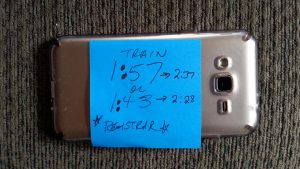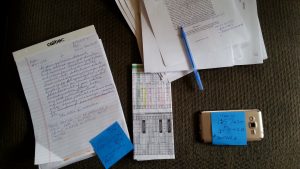I approached this week’s readings keeping last week’s readings in mind because this week’s class is Hybrid/Online Learning, Connectivism, and the University II, while also considering the prompts from the syllabus and the larger context of the Digital Pedagogy Unit we’re currently studying. At times while reading, reviewing last week’s readings and “task-switching” to print important pages and/or look up terms in the readings, it felt like juggling with all the balls in the air at the same time. But the good news is that by this morning, the readings’ content and their context started to gel.
I’d like to focus on Chapters 4-5 and Appendix in Digital Technology as Affordance and Barrier in Higher Ed (Smale and Regalado, 2017) and leave the remaining readings for class. I’m really intrigued by the very vast quantitative study that Smale and Regalado undertook, the extreme detail they went into with each participant and constituency, and their findings from a such labor-intensive research project for both participants and researchers.
Chapter 4 “College Students, Technology and Time” treats the concepts of time and space in tech. I must admit, as I stare at 4 major projects on my desk and desktop with deadlines all close to each other within the coming weeks, reading about time and time management in academic work with the task of being this week’s motivator was pushing my buttons. Still, the concept of time + space in tech is larger than my own personal situation. For example, we all experience that “digital devices teleport work into spaces and times once reserved for personal life” (Wajcman 2015, 137 in Smale and Regalado 2017, 60) and while this can be great it is also be really tricky to manage.
So I pose this opening question: how do you manage tech in spaces and times once reserved for personal life?
I myself have maintained “sacred times + spaces” such as meals with family, mornings, bedtime, and DRIVING, during which no tech is allowed. This has been a tech battle with my teen since her high school teachers use Remind apps, Google classroom, etc. and often post important info very early in the morning on the day of classes or late at night the night before classes. I get aggravated by this because I feel it erodes all the years of my parenting/modeling “no tech” at such times.
Start the day with a sun salutation not a Facebook update, please!!!
Chapter 4 also speaks to the need for students to be “adaptable” due to the vicissitudes of tech (slow wifi, smartphone charging, power outages due to weather, etc.) As a freelancer (which we’re not supposed to say anymore, I believe the correct term is now “flex time worker”) and adjunct professor, in my “lived experience”, adaptability is essential.
Do you find your students to be rigid, adaptible/flexible or just simply not skilled enough yet with tech? What are some of the affordances and barriers you encounter as teachers and in your students?
I’ve thought about this often in the context of “the trope of the digital native” (Smale and Regalado, 80). I, too, agree Smale and Regalado, who are in agreement with “Bennett and Maton (2010) who suggest we must move beyond the ‘digital natives’ debate as it currently stands” (Smale and Regalado, 75) or as Ryan Cordell articulates in “How Not to Teach the Digital Humanities” (a reading from Core 1) “digital native does not equal mastery”. (Debates in Digital Humanities 2016, 464)
In Chapter 5 “Recommendations for Technology in Higher Education” the researchers “found that fixed tech’s greatest restriction on students’ academic task-scapes is that it requires them to create academic space for themselves in locations that may be occupied by multiple other people engaged in a variety of activities… Mobile tech can allow students to transcend place… affording them the opportunity to reduce the distractions of others” (Smale and Regalado, 74) to which I’d add, provided their own distractions (notifications, updates, Snapchat selfie taking etc.) are turned off or silenced while they’re working academically, in order to amplify/maximize/dedicate time. I heard a study cited–I can’t remember the name or group which conducted it at the moment–which reported that it is estimated that women in college spend 10 hours PER DAY futzing on smartphones–why the study singled out women I don’t know–but still, this is staggering!)
To the point of time usage and economy, the students revealed a finding that the “most useful” tech was for “managing time or time-saving”. But while “technology can certainly be harnassed to provide support for student time management” (Smale & Regalado 81) I find the use of remind apps to be another tricky thing to manage in and of themselves. They’re great when the remind is programmed or the event info is input by students themselves, but if it’s part of a larger automation I think it takes away from learning the very valuable and essential time-management skills, that are also a BIG part of learning and researching.
In summary, Chapters 4, 5 and Appendix bring to light the “lived experience” of tech, or as Laurie Hurson said during a TLC workshop that I attended (which Jing and Kyueun also attended) on Teaching With the Commons when WordPress hit a bump during a demo, “this is when tech gets real”.
I’ve found that the use of tech is always about “the time created with one digital technology evaporate[ing] due to the barriers of another” (Smale & Regalado 64) and that we must CHOOSE WISELY as educators and students ourselves.
Chapters 4, 5 and Appendix also bring up the concept of BOUNDARIES in TIME/SPACE/PLACE and made me examine the following questions in regard to academic work, which: -Where do I want to work? -What time/s can I work? -WHEN do I work best? WHEN does my sched allow me to work? (often the ideal/optimal/desired times do not correspond to deadlines.)
Perhaps we could create a check list of FUNCTIONS of TECH in HIGHER ED:
-Learning
-Teaching
-Exchanging: academics, relevant anecdotes in both academic content and academic tech
-Streamlining! Less is more
What would you add this this list?
Finally, how do you think these chapters speak to the syllabus prompts:
“What are the biases of the technologies we’re using, and how can we interrogate those biases from within the environment they have created?”
It’s clear from reading Smale and Regalado’s comprehensive research that tech access + digital literacy are matters of social justice. I really liked the professor in an allied health department at City Tech who said, “as faculty we teach content, but I like to think that we, more-so, facilitate learning through technology”. (Smale & Regalado 80)
Indeed, I find this to be the mandate we face as educators.
In closing, please find photos of my own personal remind system, the very high tech Post-It Note attached to my smartphone and clothing. The most important thing about tech, low or high, is that it must work for you.
Works for me!




